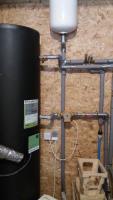 Add My Company
Add My Company
Sign In
A cautionary tale
20-04-2018

The owners of a period cottage in Hampshire decided to ask another installer to fit a heat pump system to reduce costs and reduce their heating bill and their impact on the environment. Unfortunately, things didn’t go to plan.
From the outset of the project the client was led astray by an installer who inflated the possible financial returns and ignored industry standard design principals. The result was an inefficient heat pump that perpetuates the myth that ground source heat pumps cannot heat period properties effectively, and left the clients with high running costs. When isoenergy arrived immersion heaters were topping up the limited heat pump system and an inadequate control strategy meant that the spatial heating could not get the house up to 21°C when required. Due to the undersized ground collector array, the system was extracting more heat from the ground than the environment could supply sustainably. These constant low brine temperatures eventually resulted in the heat pump failing all together.
All of these problems could have been easily avoided had the installer designed the system in line with industry standards.
Before 1Unlike the installer, Synergy Borehole Systems, who drilled the original boreholes were determined not to abandon the client. They called on isoenergy to come and review the system and advise on the best way to get it working.
isoenergy identified the key issues needing to be addressed along with a few other design options that could improve the system further.
The incoming glycol (brine) temperature on the system was running at -9°C. An operational average for a heat pump running on boreholes should be between 3 or 4°C.
The low brine temperature was a result of the borehole array being undersized by a third. The heat pump was extracting more energy than was naturally replenished.
The ‘manifold’ assembly that had been built very poor and impossible to maintain. Friction loss in the brine pipework meant the circulation pump was working harder and had burnt out once in three years already.
The domestic hot water tank had an indirect heating coil with too small a surface area to get the tank above 48°C, something a heat pump system should have no problem doing if the tank was properly specified.
manifoldThe insulation on the pipework was inadequate if present at all. What was there was held on with duct tape which certainly does not meet building regulations. The sub-zero brine temperature and uninsulated pipework caused condensation and corrosion of all the pipework and fittings.
Isoenergy stripped out the existing installation effectively starting from scratch. The heat pump system with all its connective plumbing was removed from the plantroom and reinstalled to the highest standards.
As part of the project the client also requested that Synergy come back to site and drill a third borehole to alleviating the load on the ground collector array.
isoenergy removed the unsuitable ‘manifold’ that was part of the original installation and replaced it with a purpose designed ground source heat pump manifold with flow meters, balancing and isolation valves. Each borehole was then pressure tested and the system switched on.
before3Since the refit the client has seen a marked improvement with the heat pump system and it is functioning as it should have been from the start. The brine temperatures have stabilised above freezing, the immersion heaters are not running and the plantroom has a better quality. This has led to lower running costs, increased efficiency and a working system.
before4Unsurprisingly, the company that fitted this system has now gone into administration like so many cowboy renewable energy companies. If you have been a victim of a cowboy installer, call isoenergy on 01293 821 345 or email us at energy@iso.co.uk
For more information on A cautionary tale talk to ISO Energy Ltd
Enquire Now
List your company on FindTheNeedle.
